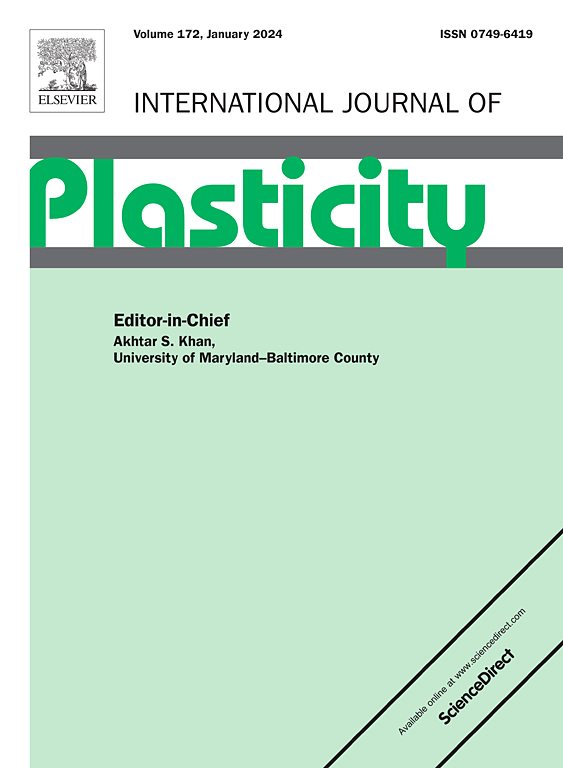Modeling hydrogen diffusion and its interaction with deformed microstructure involving phase transformation–Theory, numerical formulation, and validation
IF 12.8
1区 材料科学
Q1 ENGINEERING, MECHANICAL
引用次数: 0
Abstract
This study presents, for the first time, a model capable of simulating the complex interactions among deformation, phase transformation, and hydrogen (H) diffusion in H-charged transformation-induced plasticity (TRIP)-assisted steel. The model integrates a crystal plasticity (CP) framework with a deformation-induced martensitic transformation (DIMT) model and a H diffusion model while incorporating transformation-induced H release (TIHR). Furthermore, it accounts for H-enhanced localized plasticity (HELP) and H-enhanced phase transformation (HEPT) to capture the influence of H on mechanical behavior. The developed model is numerically implemented using the finite element method, and a series of case studies are conducted to systematically investigate the interplay between deformation, phase transformation, and H diffusion. The simulation results successfully support experimentally reported observations, demonstrating that phase transformation leads to a significant increase in H concentration within austenite and transformed martensite. This results in local oversaturation of H and anomalous diffusion, which are expected to contribute to increased susceptibility to H embrittlement (HE). These findings suggest that metastable austenite is significantly more susceptible to HE than stable austenite. Overall, the proposed model enhances the understanding of the intricate mechanisms governing H-charged TRIP-assisted steels, providing valuable insights for designing materials with improved resistance to HE.
氢扩散模型及其与相变变形微观结构的相互作用-理论,数值公式和验证
本研究首次提出了一种能够模拟H-带电相变诱导塑性(TRIP)辅助钢中变形、相变和氢(H)扩散之间复杂相互作用的模型。该模型集成了晶体塑性(CP)框架、变形诱导马氏体相变(DIMT)模型和H扩散模型,同时纳入了变形诱导H释放(TIHR)。此外,它考虑了H增强局部塑性(HELP)和H增强相变(HEPT),以捕捉H对力学行为的影响。利用有限元方法对所建立的模型进行了数值实现,并进行了一系列的实例研究,以系统地研究变形、相变和H扩散之间的相互作用。模拟结果成功地支持了实验报告的观察结果,表明相变导致奥氏体和转化马氏体中H浓度的显著增加。这导致氢的局部过饱和和异常扩散,这将有助于增加对氢脆(HE)的敏感性。这些发现表明,亚稳态奥氏体比稳定奥氏体更容易受到HE的影响。总的来说,所提出的模型增强了对控制带h电荷的trip辅助钢的复杂机制的理解,为设计具有更高HE抗性的材料提供了有价值的见解。
本文章由计算机程序翻译,如有差异,请以英文原文为准。
求助全文
约1分钟内获得全文
求助全文
来源期刊

International Journal of Plasticity
工程技术-材料科学:综合
CiteScore
15.30
自引率
26.50%
发文量
256
审稿时长
46 days
期刊介绍:
International Journal of Plasticity aims to present original research encompassing all facets of plastic deformation, damage, and fracture behavior in both isotropic and anisotropic solids. This includes exploring the thermodynamics of plasticity and fracture, continuum theory, and macroscopic as well as microscopic phenomena.
Topics of interest span the plastic behavior of single crystals and polycrystalline metals, ceramics, rocks, soils, composites, nanocrystalline and microelectronics materials, shape memory alloys, ferroelectric ceramics, thin films, and polymers. Additionally, the journal covers plasticity aspects of failure and fracture mechanics. Contributions involving significant experimental, numerical, or theoretical advancements that enhance the understanding of the plastic behavior of solids are particularly valued. Papers addressing the modeling of finite nonlinear elastic deformation, bearing similarities to the modeling of plastic deformation, are also welcomed.
 求助内容:
求助内容: 应助结果提醒方式:
应助结果提醒方式:


